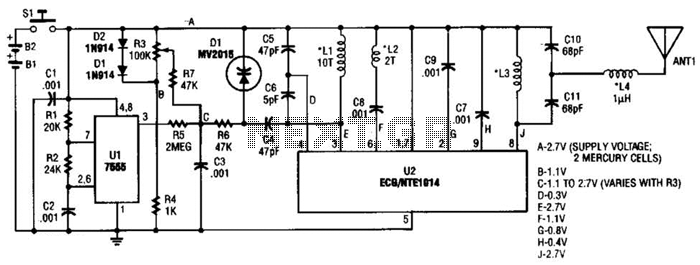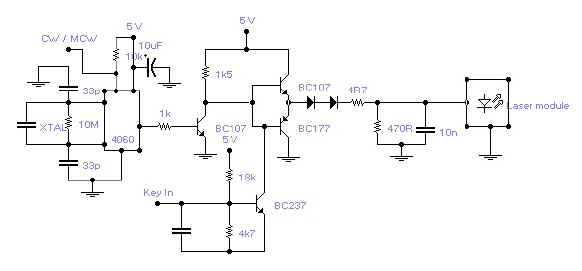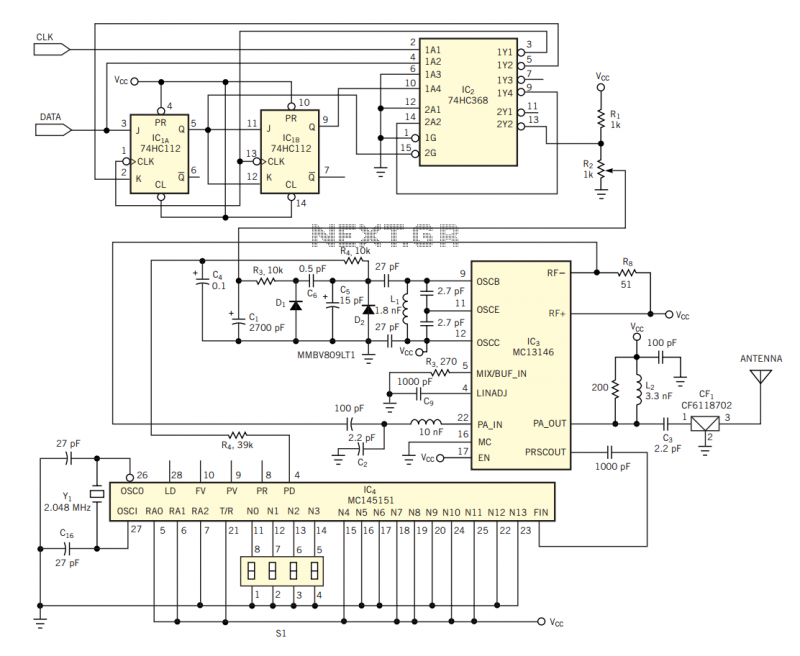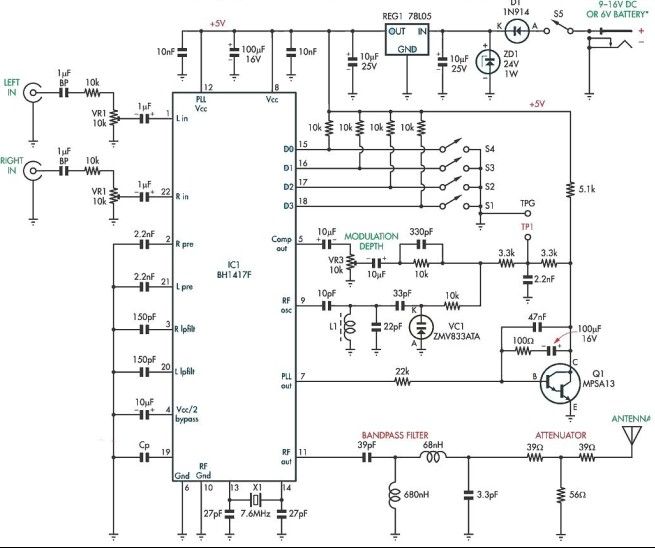
Transmit Infrared Signals Through Walls
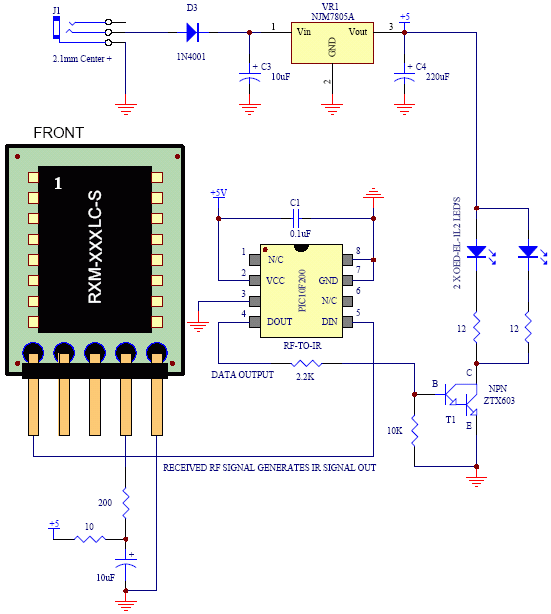
Instructions for utilizing an existing infrared transmitter from any room within the house. The concept is straightforward and operates more effectively than anticipated. This project proves to be quite useful, allowing control over devices from virtually anywhere. For instance, stereo equipment can be housed within an enclosure while still using the existing infrared remote control without requiring a direct line of sight. Volume adjustments can be made from various rooms in the house. Testing has been conducted with televisions, stereos, VCRs, and CD players, enabling channel changes and volume adjustments from any location within the house (and even outside) where the infrared to radio frequency (RF) circuit is implemented as shown in Figure #1. The RF to infrared circuit shown in Figure #2 is positioned on a bookshelf across the living room, directed towards the TV and stereo. It is possible to extend the infrared LED using long wires directly to the front of the equipment needing control, eliminating the need for the Zetex 603 High-Current IR LED drive circuit. While higher power usage may be preferred to test limits, a simpler approach can be taken by directly driving the infrared LED with a single series resistor connected to the 40kHz modulating PIC for shorter range operation. The existing infrared remote control for the TV will be utilized to transmit to the infrared detector depicted in Figure #1. The infrared signal from the transmitter is output through the TSOP-1140 40kHz infrared detector module's data output pin (labeled RX DOUT) in Figure #1. This output feeds into the TXLC-315 RF transmitter module via a 2N3906 PNP transistor inverter circuit. When no data is received from the infrared transmitter, both the PNP transistor and TXLC-315 RF module remain off. The inverter circuit is necessary because the TXLC-315 data input must be grounded during idle periods. The output from the TSOP-1140 IR detector idles at logic high (1). Directly applying this logic high to the TXLC-315 data input would keep the RF transmitter constantly active, which is undesirable. The goal is to activate the RF transmitter only when data is received from the infrared transmitter, thereby recreating the same signal sent by the infrared transmitter. This is the function of the PNP inverter circuit. Essentially, the system converts infrared signals into RF, as the IR detector output modulates the RF module to replicate the original signal, now in RF form. The infrared transmitter can send data from any room by installing the circuit illustrated in Figure #1 on the TV infrared transmitter or constructing one of the circuits shown in Figure #1 for each room. The next step involves implementing a circuit that receives the RF signal and converts it back into an infrared signal. The circuit shown in Figure #2 fulfills this requirement. Note that the RXLC-315 circuit boards have been updated to a 5-pin configuration from the previous 4-pin version. A link to the older version board (and the previous RF-to-IR IC) is provided below. Users with the newer 5-pin modules and PIC10F200 RF-to-IR IC should refer to Figure #2. The RXLC-315 RF receiver module captures the incoming RF transmission from the TXLC-315 transmitter. The RXLC-315 then outputs this data stream to the DIN pin of the 8-pin IC labeled RF-to-IR illustrated in Figure #2. This 8-pin IC is a custom programmed PIC10F200 that samples the data input pin labeled DIN and recreates the same data signal modulated at 40kHz. This process effectively converts the incoming data back into a modulated infrared signal, allowing for the use of a standard TV or other appliance infrared transmitter anywhere in the house with existing devices such as stereos, TVs, CD players, etc. To compile the code mentioned, the Microchip MPASM assembler, a PIC programmer, and a PIC10F200 are required.
The project involves two primary circuits: the infrared to RF circuit and the RF to infrared circuit. The first circuit captures infrared signals using the TSOP-1140 detector, which is sensitive to 40kHz modulated signals. This signal is then inverted using a PNP transistor before being sent to the TXLC-315 RF transmitter, which transmits the modulated signal over RF frequencies. The RF receiver circuit, comprising the RXLC-315 module, captures the transmitted RF signals and feeds them into the RF-to-IR IC, which demodulates the RF signal back into an infrared format, allowing control of IR devices remotely.
For practical implementation, the components required include the TSOP-1140 IR detector, TXLC-315 RF transmitter, RXLC-315 RF receiver, and the PIC10F200 microcontroller. The design must take into account the power supply requirements for each module, ensuring that adequate voltage and current levels are maintained for reliable operation. The PNP transistor inverter circuit must be configured correctly to prevent unintended activation of the RF transmitter. Additionally, careful attention should be paid to the layout of the circuit to minimize interference and ensure stable operation, particularly in environments with multiple electronic devices.
By following the outlined procedures and utilizing the specified components, users can successfully create a system that allows for seamless control of infrared devices from any location within the house, enhancing convenience and functionality in home entertainment systems.How to use your existing infrared transmitter from any room in the house. The principal is really pretty simple, and it works better than you would think. This is a "very handy" little project. With this gadget you can control anything from pretty much anywhere. Even place your stereo equipment inside an enclosure then use your existing IR remote control without line of sight. Adjust the volume on your stereo from other rooms in the house. You name it - so enjoy. ;o] I have tested both circuits with TV`s, stereo`s, and various VCR`s & CD players. I can change channels, adjust volume, etc, from any room in the house (and outside) where I have the IR to RF circuit in Figure #1. The RF to IR circuit in Figure #2 is placed on a bookshelf across our living room, and aimed in the direction of our TV & stereo.
Note: You can place the IRLED on long wires to extend it right onto the front of the equipment you need to control and do away with the Zetex 603 High-Current IRLED drive circuit. I`m a little power hungry, and always like to see just how far I can push the envelope, but you may prefer to tone this down a bit.
You can directly drive the IRLED with a single series resistor on the 40kHz modulating PIC for much shorter range operation. We`ll use our existing infrared remote control transmitter for our TV. We`ll transmit to the IR detector shown in Figure #1 below. The IR signal from our transmitter is output on the TSOP-1140 40kHz IR detector module data output pin (labeled RX DOUT) in Figure #1.
The IR detectors output signal feeds data to the input of the TXLC-315 RF transmitter module through the 2N3906 PNP transistor inverter circuit. When no data is being received from the IR transmitter, the PNP transistor & TXLC-315 RF module are both OFF.
We need this inverter circuit since the TXLC-315 data input needs to be held at ground during idle (non-transmit) periods. The output of the TSOP-1140 IR detector idles at logic 1. Applying this logic 1 directly to the TXLC-315 data input would cause the TXLC-315 RF transmitter to always be ON.
We don`t want this. We only want incoming data from the IR transmitter to turn ON the RF transmitter to re-create the same signal the IR transmitter is sending. That`s the purpose of the PNP inverter circuit. In essence, we`re simply turning IR into RF since the IR detector output will now modulate our RF module thereby re-creating the same signal, but now it`s RF instead of infrared.
We use our IR transmitter to send data from any room in the house by installing the circuit shown below in Figure #1 on our TV IR transmitter, or building one of the circuits shown in Figure #1 for each room. Now all we need is the circuit that receives the RF signal, then re-creates this same data signal in infrared.
The circuit shown below in Figure #2 does exactly what we need. Note: We`ve revised the RXLC-315 circuit boards. These are now 5-pin VS the old 4-pin boards. We`ve included a link to the older version board (and old version RF-TO-IR IC) for this project below. Anyone using the newer 5-pin modules & PIC10F200 RF-TO-IR IC, refer to Figure #2. The RXLC-315 RF receiver module receives the incoming RF transmission from the TXLC-315 transmitter. The RXLC-315 outputs this incoming data stream to the DIN pin of the 8-pin IC labeled RF-TO-IR shown above in Figure #2.
The 8-pin IC is a custom programmed PIC10F200 that samples the data input pin labeled DIN, then re-creates this same data signal modulated at 40Khz. Presto. We now have turned our incoming data back into a modulated IR signal, and we now have a standard TV or other appliance IR transmitter we can use anywhere in the house with our existing stereo, TV, CD players, etc, etc.
To assemble the code below you`ll need the Microchip MPASM assembler, a PIC programmer, and, of course, a PIC10F2 🔗 External reference
The project involves two primary circuits: the infrared to RF circuit and the RF to infrared circuit. The first circuit captures infrared signals using the TSOP-1140 detector, which is sensitive to 40kHz modulated signals. This signal is then inverted using a PNP transistor before being sent to the TXLC-315 RF transmitter, which transmits the modulated signal over RF frequencies. The RF receiver circuit, comprising the RXLC-315 module, captures the transmitted RF signals and feeds them into the RF-to-IR IC, which demodulates the RF signal back into an infrared format, allowing control of IR devices remotely.
For practical implementation, the components required include the TSOP-1140 IR detector, TXLC-315 RF transmitter, RXLC-315 RF receiver, and the PIC10F200 microcontroller. The design must take into account the power supply requirements for each module, ensuring that adequate voltage and current levels are maintained for reliable operation. The PNP transistor inverter circuit must be configured correctly to prevent unintended activation of the RF transmitter. Additionally, careful attention should be paid to the layout of the circuit to minimize interference and ensure stable operation, particularly in environments with multiple electronic devices.
By following the outlined procedures and utilizing the specified components, users can successfully create a system that allows for seamless control of infrared devices from any location within the house, enhancing convenience and functionality in home entertainment systems.How to use your existing infrared transmitter from any room in the house. The principal is really pretty simple, and it works better than you would think. This is a "very handy" little project. With this gadget you can control anything from pretty much anywhere. Even place your stereo equipment inside an enclosure then use your existing IR remote control without line of sight. Adjust the volume on your stereo from other rooms in the house. You name it - so enjoy. ;o] I have tested both circuits with TV`s, stereo`s, and various VCR`s & CD players. I can change channels, adjust volume, etc, from any room in the house (and outside) where I have the IR to RF circuit in Figure #1. The RF to IR circuit in Figure #2 is placed on a bookshelf across our living room, and aimed in the direction of our TV & stereo.
Note: You can place the IRLED on long wires to extend it right onto the front of the equipment you need to control and do away with the Zetex 603 High-Current IRLED drive circuit. I`m a little power hungry, and always like to see just how far I can push the envelope, but you may prefer to tone this down a bit.
You can directly drive the IRLED with a single series resistor on the 40kHz modulating PIC for much shorter range operation. We`ll use our existing infrared remote control transmitter for our TV. We`ll transmit to the IR detector shown in Figure #1 below. The IR signal from our transmitter is output on the TSOP-1140 40kHz IR detector module data output pin (labeled RX DOUT) in Figure #1.
The IR detectors output signal feeds data to the input of the TXLC-315 RF transmitter module through the 2N3906 PNP transistor inverter circuit. When no data is being received from the IR transmitter, the PNP transistor & TXLC-315 RF module are both OFF.
We need this inverter circuit since the TXLC-315 data input needs to be held at ground during idle (non-transmit) periods. The output of the TSOP-1140 IR detector idles at logic 1. Applying this logic 1 directly to the TXLC-315 data input would cause the TXLC-315 RF transmitter to always be ON.
We don`t want this. We only want incoming data from the IR transmitter to turn ON the RF transmitter to re-create the same signal the IR transmitter is sending. That`s the purpose of the PNP inverter circuit. In essence, we`re simply turning IR into RF since the IR detector output will now modulate our RF module thereby re-creating the same signal, but now it`s RF instead of infrared.
We use our IR transmitter to send data from any room in the house by installing the circuit shown below in Figure #1 on our TV IR transmitter, or building one of the circuits shown in Figure #1 for each room. Now all we need is the circuit that receives the RF signal, then re-creates this same data signal in infrared.
The circuit shown below in Figure #2 does exactly what we need. Note: We`ve revised the RXLC-315 circuit boards. These are now 5-pin VS the old 4-pin boards. We`ve included a link to the older version board (and old version RF-TO-IR IC) for this project below. Anyone using the newer 5-pin modules & PIC10F200 RF-TO-IR IC, refer to Figure #2. The RXLC-315 RF receiver module receives the incoming RF transmission from the TXLC-315 transmitter. The RXLC-315 outputs this incoming data stream to the DIN pin of the 8-pin IC labeled RF-TO-IR shown above in Figure #2.
The 8-pin IC is a custom programmed PIC10F200 that samples the data input pin labeled DIN, then re-creates this same data signal modulated at 40Khz. Presto. We now have turned our incoming data back into a modulated IR signal, and we now have a standard TV or other appliance IR transmitter we can use anywhere in the house with our existing stereo, TV, CD players, etc, etc.
To assemble the code below you`ll need the Microchip MPASM assembler, a PIC programmer, and, of course, a PIC10F2 🔗 External reference
